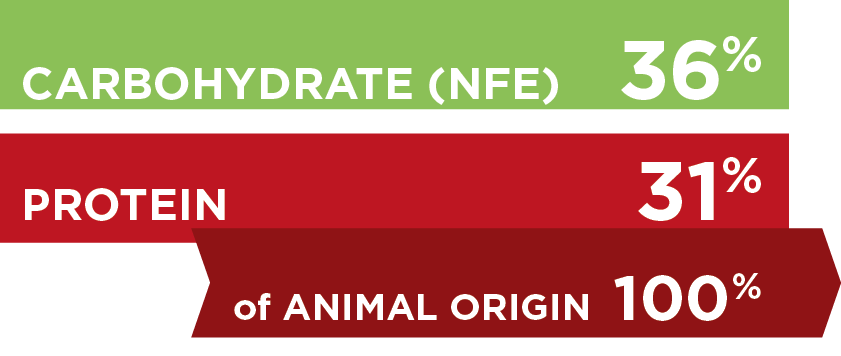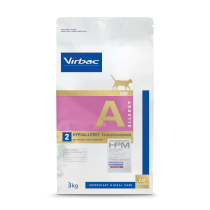VETERINARY HPM® Hypoallergy Cat
With hydrolysed fish protein
Clinical Indications
• Reduction of ingredient and nutrient intolerance.
Available formats: 3kg

OTHER USE
- Food intolerance with concurrent digestive disorders (maldigestion/malabsorption, diarrhoea)
- Food intolerance with concurrent skin/coat disorders (redness/itching)
CONTRAINDICATIONS
- Growth
- Gestation & Lactation
- Chronic Kidney Disease
KEY BENEFITS & CHARACTERISTICS
Elimination Diet
Formula based on hydrolysed fish protein and tapioca allows management of most common food allergies.
Purified Source of Carbohydrate (single source)
The use of tapioca (purified starch from manioc) excludes the protein part of manioc.
With Hydrolysed Fish Protein
Fish protein is extensively hydrolysed to achieve low molecular weight (mean MW of 1.78 kDa, 98% peptides below 10 kDa) ensuring food allergy management. Its high digestibility and biological value (amino acid profile) perfectly fit the daily requirements of cats.
High Digestive Tolerance
Includes a specific association of ingredients (clay, probiotics, prebiotics, selected fibres) to secure the digestive function, which can be compromised in allergic cats (efficacy proven by Virbac)(1)
High Palatability
Richness in animal protein and fat guarantees high palatability for optimal compliance during the elimination food trial or in the long term (efficacy proven by Virbac)(1)

ADDITIONAL BENEFITS & CHARACTERISTICS
Skin Integrity
Balanced omega-6 and omega-3 help reinforce natural skin defences and reduce the risk of other allergies.
Coat Support
Adapted content in protein and essential fatty acids helps to maintain a healthy coat.
High Digestibility
High digestibility helps support cats with concurrent compromised gastrointestinal function.
Urinary Health
Mineral balance and adapted urinary pH and RSS limit the risk of feline lower urinary tract disease in the long term.
Suitable for Adult and Senior cats
The amounts of all essential nutrients fit the daily requirement of adult and senior cats.

ANALYTICAL CONSTITUENTS (% as fed)
- Moisture 5.5
- Protein 31
- Animal to vegetable ratio 100/00
- Fat 16
- Minerals 7.5
- Crude Fibre 4
- NFE 36
- Starch 32
- Calcium 0.8
- Phosphorus 0.7
- Sodium 0.7
- Methionine + Cystine 1.5
- Omega-6 fatty acids 3
- Omega-3 fatty acids 0.7
KEY NUTRIENT VALUES
- Metabolisable energy (kcal/100g) 389
- Metabolisable energy in vivo (kcal/100g) 383
- Protein digestibility (in vivo; %) 89
- Fat digestibility (in vivo; %) 93
- Energy from protein (%) 29
- Energy from fat (%) 37
- Energy from NFE (%) 34
- Protein to Calorie ratio (g/Mcal) 80
COMPOSITION
Tapioca(1), hydrolysed salmon protein(2) (33%), animal fats, minerals, hydrolysed pork proteins(2), lignocellulose, beet pulp, brewers yeast, fructo-oligosaccharides, fish oil, mono di and tri glycerides of fatty acids, hydrolysed crustacean (source of chitosan), chondroitin sulfate, Lactobacillus acidophilus.
1) Carbohydrate source
2) Protein sources
SPECIFIC INGRIDIENTS/ADDITIVES
- Bentonite 0.5%
- Pasteurised Lactobacilli 7 mg/kg
- Chitosan 800 mg/kg
- L-carnitine 540 mg/kg
Veterinary Global Care

Management of concurrent conditions
FOOD INTOLERANCE/ALLERGY MANAGEMENT
Elimination Diet Hydrolysed salmon protein
Tapioca (purified manioc starch)
Support of primary condition
GASTRO INTESTINAL DISORDERS
High digestive tolerance (Clay, probiotics, prebiotics)
High nutrient digestibility SKIN & COAT DISORDERS
Balanced essential fatty acids
Balanced amino acids
Additional health benefits
Urinary health
References
* Comission Directive 2008/38/EC
- Leriche I et al. Assessment of the palatability and digestive tolerance in cats of a new diet based on hydrolysed salmon as the protein source. Internal data 2018.

